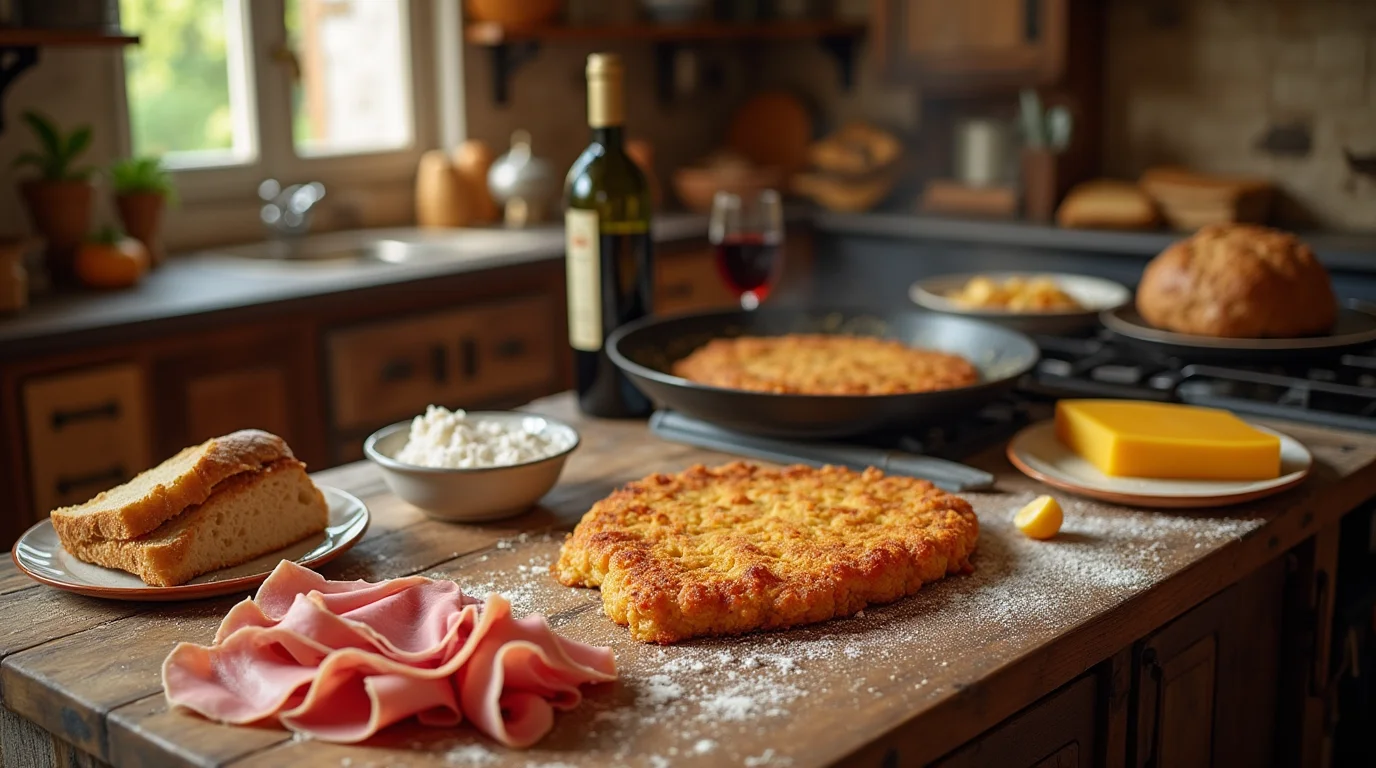What Is a Cachopo Recipe ? Traditional Recipe and Cooking Tips
Table of Contents
Introduction: A Taste of Asturias in Your Own Kitchen
Have you ever craved a dish that’s both hearty and indulgent, one that combines the rich flavors of tender beef, savory ham, and melted cheese, all encased in a crispy, golden coating? If so, you’re in for a treat. The cachopo recipe is exactly what you need—an iconic dish from the region of Asturias, Spain, that’s as comforting as it is delicious. Whether you’re looking to recreate this culinary masterpiece in your own kitchen or simply want to learn about its rich history, you’re in the right place.
Picture this: a crispy, golden crust, revealing layers of succulent beef, salty ham, and gooey cheese—each bite is a perfect balance of textures and flavors. And best of all, making cachopo at home is not only achievable but incredibly rewarding. In this article, I’ll guide you through everything you need to know—from the traditional cachopo recipe to tips and tricks for making it just right. By the end, you’ll be ready to impress your family and friends with your own homemade version of this legendary dish.
What Is a Cachopo? Exploring This Asturian Classic
Origin and History of Cachopo
The cachopo is a dish that originates from Asturias, a region in northern Spain known for its lush landscapes, cider, and hearty food. This iconic dish features two tender beef fillets, typically stuffed with ham and cheese, then breaded and fried until golden and crispy.
The cachopo is much more than a meal; it’s a symbol of the region’s culinary traditions and an embodiment of Spanish comfort food. Historically, cachopo was a dish that provided a hearty and affordable meal for the working class. It was often served during celebrations or gatherings, offering a satisfying, filling meal that could easily be shared among friends and family.
While cachopo is often compared to dishes like schnitzel or cordon bleu, the key difference lies in the layers of fillings and the choice of meats. Though the dish has gained popularity across Spain, it remains a cherished specialty in Asturias, where local variations include the use of regional cheeses and cured meats.
Key Ingredients of a Traditional Cachopo
At the heart of the cachopo is its simplicity. The classic ingredients include:
- Beef fillets: The star of the show, these fillets should be tender cuts, such as sirloin or rib-eye, which can be pounded thin for easy rolling.
- Ham: Serrano ham is the traditional choice, though prosciutto or other cured hams can work just as well.
- Cheese: The most common cheese used in a cachopo is Manchego, but you can also experiment with other types like Idiazabal or even mozzarella for a creamier texture.
- Breadcrumbs: The breadcrumbs give the cachopo its signature crunchy exterior, providing a satisfying contrast to the tender meat and gooey cheese inside.
- Flour and Eggs: To coat the beef and ensure the breadcrumbs stick perfectly, you’ll need a light flour coating and beaten eggs.
Other optional ingredients include vegetables, such as mushrooms or peppers, that can be added to the filling for a bit of extra flavor. In some modern versions of the dish, even seafood or chicken might be used in place of beef, adding a new spin to this traditional recipe.
How to Make a Traditional Cachopo: Step-by-Step Recipe
Preparation Essentials
The secret to a great cachopo lies in its preparation. Here are the steps to follow for a flawless dish:
Choosing the Best Cuts of Beef
To make a memorable cachopo, the quality of the beef is essential. Opt for tender cuts like sirloin or rib-eye. These cuts are rich in flavor and remain juicy after frying. When buying the beef, ask your butcher to slice the fillets into large pieces, then pound them to about ¼ inch thickness. This ensures that the beef cooks evenly and is easy to roll.
Preparing the Fillings
The traditional filling for a cachopo includes two slices of Serrano ham and a few generous slices of cheese. But don’t be afraid to get creative! You can experiment with different types of ham or cheese, or even add a little bit of mustard or herbs for extra flavor. Be sure to lay the fillings on one side of the beef fillet, leaving enough space at the edges to seal it tightly.
Cooking Method
Now comes the fun part—actually putting the cachopo together and cooking it to perfection.
Step 1: Assemble the Cachopo
- Lay one beef fillet flat on a clean surface.
- Place a slice of ham and cheese in the center of the fillet, ensuring they are centered and not spilling over the edges.
- Place the second fillet on top, pressing down gently to seal the two pieces together. Secure the edges by gently pinning them with toothpicks or kitchen twine.
Step 2: Coat the Cachopo
For the perfect crunch, you’ll need to coat the assembled cachopo in a flour and breadcrumb mixture. Here’s how:
- Dredge the filled fillet in flour, ensuring it is completely covered.
- Dip the fillet in a beaten egg, making sure the coating sticks to the beef.
- Finally, coat the fillet in seasoned breadcrumbs. For extra crunch, you can double-coat by repeating the egg and breadcrumb steps.
Step 3: Fry to Perfection
Now it’s time to fry your cachopo! Heat a generous amount of olive oil in a deep skillet over medium-high heat. Once the oil is hot, carefully add the cachopo and fry for about 4-5 minutes on each side, or until the crust is golden brown and crispy. Be mindful not to overcrowd the pan, as this could cause the oil temperature to drop and result in soggy breading.
Once fried, remove the cachopo from the oil and place it on a paper towel-lined plate to drain any excess oil. Let it rest for a minute before cutting into it to serve.
Expert Cooking Tips for the Perfect Cachopo
To ensure your cachopo turns out perfectly every time, here are some expert tips:
- Choose Fresh, High-Quality Ingredients: The beef should be tender and of good quality. Fresh, flavorful Serrano ham and good-quality cheese will make all the difference.
- Seal the Edges Well: Make sure the edges of your cachopo are tightly sealed to prevent the filling from spilling out during frying.
- Double Coat for Extra Crunch: For an even crunchier texture, try double-coating the cachopo with breadcrumbs.
- Control Oil Temperature: The oil should be hot enough to fry the cachopo without making it greasy. If the oil is too hot, the breading may burn before the meat cooks through. If it’s too cold, the cachopo will absorb too much oil and become soggy.
Cachopo Variations to Try
While the classic cachopo recipe is delicious on its own, there are many variations to experiment with. Here are some creative twists:
- Vegetarian Cachopo: Use eggplant or zucchini slices as a substitute for the beef fillets. Stuff with cheese and vegetables for a lighter version.
- Seafood Cachopo: Try using fish fillets or prawns as the filling. A salmon cachopo or shrimp cachopo can offer a refreshing twist.
- Chicken Cachopo: Replace the beef with chicken breast for a leaner option. It’s just as delicious!
Pairing Cachopo with Drinks
A great dish deserves a great drink pairing. Here are some ideas:
- Red Wine: A medium-bodied Spanish red wine, such as Rioja or Tempranillo, pairs beautifully with the richness of cachopo.
- Craft Beer: Opt for a malty beer, like a lager or pale ale, which complements the crispy exterior and savory filling.
- Non-Alcoholic: If you prefer something lighter, try sparkling water or a refreshing herbal iced tea to cleanse your palate.
FAQ About Cachopo Recipe
What is a cachopo made of?
A cachopo is made from two beef fillets, stuffed with ham and cheese, then coated in breadcrumbs and fried to golden perfection.
Can I bake cachopo instead of frying it?
Yes, you can bake a cachopo in the oven at 375°F (190°C) for about 20-25 minutes, or until golden brown and cooked through. Be sure to lightly coat it with oil before baking.
What are the best sides to serve with cachopo?
Fries, roasted vegetables, or a fresh green salad are the perfect sides to serve with cachopo.
Is cachopo gluten-free?
Traditional cachopo is not gluten-free due to the breadcrumbs. However, you can easily make it gluten-free by using gluten-free breadcrumbs or flour.
Where can I find authentic cachopo in Asturias?
You can find cachopo in most traditional restaurants across Asturias, especially in cities like Oviedo and Gijón. Some renowned spots include El Raitán and La Taberna del Zurdo.
Conclusion: Your Perfect Cachopo Awaits
The cachopo recipe is a true celebration of Spanish cuisine. With a few simple ingredients and a little bit of patience, you can recreate this delicious and hearty dish at home. Whether you stick to the traditional version or experiment with your own fillings, the cachopo is sure to become a favorite in your kitchen.







